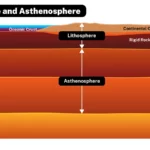This article explores the chemical compound mercury(II) oxide (HgO), focusing on its molar mass, properties, and applications. We’ll clarify common misconceptions about its molarity and delve into the importance of understanding molar mass for various chemical calculations. Uncover the intriguing details about the Earth’s outermost layer by delving into the lithosphere mod, gaining valuable insights into its composition and significance.
Decoding the Molar Mass of HgO
Molar mass is a fundamental concept in chemistry. It represents the mass of one mole of a substance, providing a crucial link between the macroscopic world (grams) and the microscopic world (atoms and molecules). A mole is simply a unit of measurement, equivalent to approximately 6.022 x 10²³ particles (Avogadro’s number). This large number allows chemists to work with manageable quantities of atoms and molecules.
To calculate the molar mass of HgO, we add the atomic masses of mercury (Hg) and oxygen (O), which can be found on the periodic table:
- Mercury (Hg): ~200.59 g/mol
- Oxygen (O): ~15.999 g/mol
Molar mass of HgO = (1 × 200.59 g/mol) + (1 × 15.999 g/mol) ≈ 216.59 g/mol
Therefore, one mole of HgO weighs approximately 216.59 grams. This value is essential for stoichiometric calculations, allowing us to convert between grams and moles, and to determine the amounts of reactants and products in chemical reactions involving HgO.
Understanding HgO Variations
It’s important to distinguish between different notations involving HgO:
- HgO(s): The “(s)” indicates that HgO is in its solid state, which doesn’t affect its molar mass.
- 2HgO: This represents two moles of HgO. The total mass would be double the molar mass (approximately 433.18 grams).
Calculating the Mass of 2 Moles of HgO
Building upon our understanding of molar mass, we can easily determine the mass of 2 moles of HgO:
Mass of 2 moles of HgO = 2 moles × 216.59 g/mol ≈ 433.18 grams
This simple calculation demonstrates the practical application of molar mass. Imagine you need a specific amount of HgO for a chemical reaction. By knowing the molar mass, you can accurately measure the required mass in grams.
Addressing the Molarity Misconception
The question “What is the molarity of HgO?” often arises. However, molarity, a measure of concentration (moles of solute per liter of solution), is not applicable to HgO. This is because HgO is practically insoluble in water. It doesn’t dissolve to form a solution, making the concept of molarity meaningless in this context. Additionally, explore the fascinating world of mediastinal shift, a critical medical condition affecting the positioning of vital organs within the chest.
Exploring the Properties and Applications of HgO
HgO typically exists as a red or orange solid at room temperature. Interestingly, two forms exist with the same structure but different particle sizes, probably contributing to the color variations. A rare mineral form called montroydite also occurs naturally.
Historically, HgO had various applications, including oxygen production, batteries, and antiseptics. However, due to the toxicity of mercury, safer alternatives are now favored, and HgO usage has significantly decreased. Ongoing research continues to explore less hazardous substitutes.
Safety Precautions with HgO
It’s crucial to handle HgO with caution, as it is a toxic substance. Avoid inhalation, ingestion, and skin contact. Always adhere to strict safety protocols when working with HgO in a laboratory setting.
Delving Deeper into HgO Chemistry
How to Calculate the Molar Mass of HgO
Calculating the molar mass of HgO is straightforward:
- Identify the constituent elements: Mercury (Hg) and oxygen (O).
- Obtain atomic masses: From the periodic table (Hg ≈ 200.59 g/mol, O ≈ 15.999 g/mol).
- Calculate the molar mass: (1 × atomic mass of Hg) + (1 × atomic mass of O) ≈ 216.59 g/mol.
Decomposition of HgO
Upon heating, HgO decomposes into mercury (Hg) and oxygen (O₂): 2HgO(s) → 2Hg(l) + O₂(g). The molar mass of O₂ is 32.00 g/mol. This decomposition reaction has historical significance regarding oxygen’s discovery.
Isotopes and Molar Mass Variation
Remember that atomic weights are average values. Isotopes, which are atoms of the same element with different numbers of neutrons, can cause slight variations in molar mass. However, using standard average atomic weights is sufficient for most practical applications.
Uncertainty in Chemistry
The “~” symbol denotes approximation. In chemistry, absolute certainty is often elusive. Understanding the degree of uncertainty associated with measurements and calculations is crucial, particularly in complex experiments where small variations can have significant consequences.
This comprehensive exploration of HgO, covering its molar mass, properties, applications, and safety considerations, aims to provide a clear and nuanced understanding of this fascinating yet hazardous chemical compound. Remember that while our current knowledge is extensive, ongoing research continues to refine our understanding of HgO and its interactions within the broader chemical landscape.
- Unlock Filipino Culture: A Deep Dive into Traditions and Practices - April 23, 2025
- Unlock Spanish Culture: Insights & Opportunities Now - April 23, 2025
- White Spirit Uses & Substitutes: A Deep Dive for Pros & DIYers - April 23, 2025

















2 thoughts on “Understanding HgO (Mercury(II) Oxide): Molar Mass, Properties, and Applications”
Comments are closed.